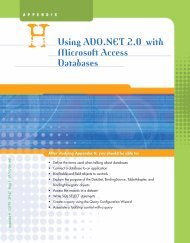Create successful ePaper yourself
Turn your PDF publications into a flip-book with our unique Google optimized e-Paper software.
C-70 Appendix C<br />
EXAMPLE<br />
3 Values of Some Expressions Involving the Second Version<br />
of the Inverse Secant<br />
p<br />
You can show that Sec 1 2 3, Sec[Sec 1 (5)] 5, and Sec 1 (Sec 2 as in<br />
Example 1. However, Arcsec(12) the unique number in [0, p 3 ) 2<br />
5p<br />
whose secant is 12 3p 2 ) 3<br />
(p 2 , p]<br />
4 , not as in Example 1.<br />
4<br />
Note: Sec 1 x sec 1 x for x 1, but Sec 1 x 2p sec 1 x for x 1.<br />
EXAMPLE<br />
4 Evaluating Expressions Involving the Second Version of the Inverse Secant<br />
sin[Sec 1 ( 5 2)] 1215 as in Example 2(a). Or, by the previous note,<br />
œ„„ 55<br />
8<br />
~<br />
¨<br />
3<br />
y<br />
¨<br />
x<br />
8<br />
sin c Sec 1 a 5 2 bd sin c sec1 a 5 121<br />
bd <br />
2 5<br />
But, Sec 1 ( 3) is in ( p 2, p], sec 1 ( 3) is in [p, 3p and neither equals p.<br />
(Why?) So and in fact Z tan [sec 1 8<br />
tan[Sec 1 8<br />
Sec 1 8<br />
( 3) sec 1 2 ),<br />
8<br />
( 3),<br />
( 3)] ( 3)].<br />
To evaluate let u Sec 1 8<br />
tan[Sec 1 8<br />
( 3)],<br />
( 3) and let ũ be its reference angle.<br />
Then u is in ( p 2, p] and Sec u 8 3. Using the right triangle labeled in Figure E,<br />
we have<br />
opposite<br />
ũ <br />
Why is<br />
adjacent 155<br />
tan[Sec 1 8<br />
( 3)] tan u tan<br />
3 tan tan ˜?<br />
8<br />
Figure E<br />
Alternatively, using identities, sec u 8 3, so<br />
155<br />
tan u 2sec 2 u 1 2( 83) 2 1 <br />
3<br />
Why the negative<br />
square root?<br />
Exercises<br />
In each of these exercises the secant and the Secant are the restricted versions<br />
defined in this project, so the inverse secant and the inverse Secant are the corresponding<br />
inverse functions.<br />
1. Evaluate the following quantities:<br />
(a) sec 1 (0) (c) arcsec(1) (e) arcsec 12<br />
(b) sec 1 1 2132 (d) sec[sec 1 (10)] (f) sec 1 (sec 4)<br />
2. Evaluate the following quantities:<br />
(a) (b) sin[arcsec(5)] (c) tan3sec 1 7<br />
cos3sec 1 1 6 524<br />
1 3 24<br />
3. Evaluate the following quantities:<br />
(a) Sec 1 (1) (c) Arcsec(2) (e) Sec[Sec 1 (15)]<br />
(b) Sec 1 (Sec 2) (d) (f) tan3Sec 1 15<br />
sin3Sec 1 1 13 5 24<br />
1 7 24<br />
4. Prove<br />
Sec 1 x sec 1 x for x 1<br />
and<br />
Sec 1 x 2p sec 1 x for x 1<br />
5. Use the result in Problem 4 to show that<br />
tan3sec 1 8<br />
tan3Sec 1 8<br />
1 324 1 324 1553<br />
6. Explain why each of the following statements is true:<br />
(a) sec[Sec 1 (3)] 3<br />
(e) Sec 1 3sec1 4 324 4<br />
(b) sec[Sec 1 (3)] is undefined (f) sec 1 3Sec 3p<br />
(c) Sec[sec 1 (8)] 8 (g) sec 1 4 4 5p 3<br />
4<br />
(Sec 2) 2p 2<br />
(d) Sec[sec 1 (8)] is undefined
















